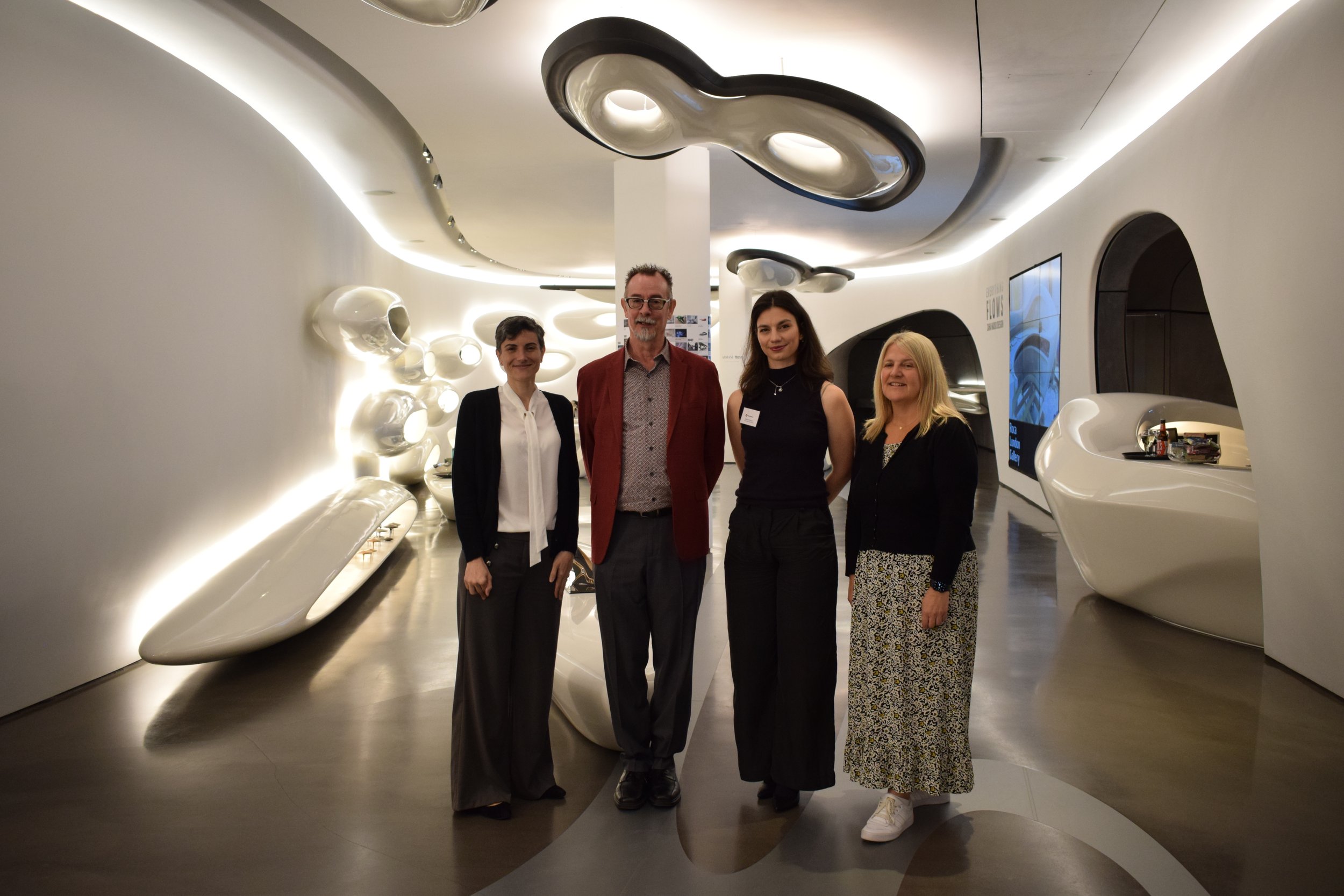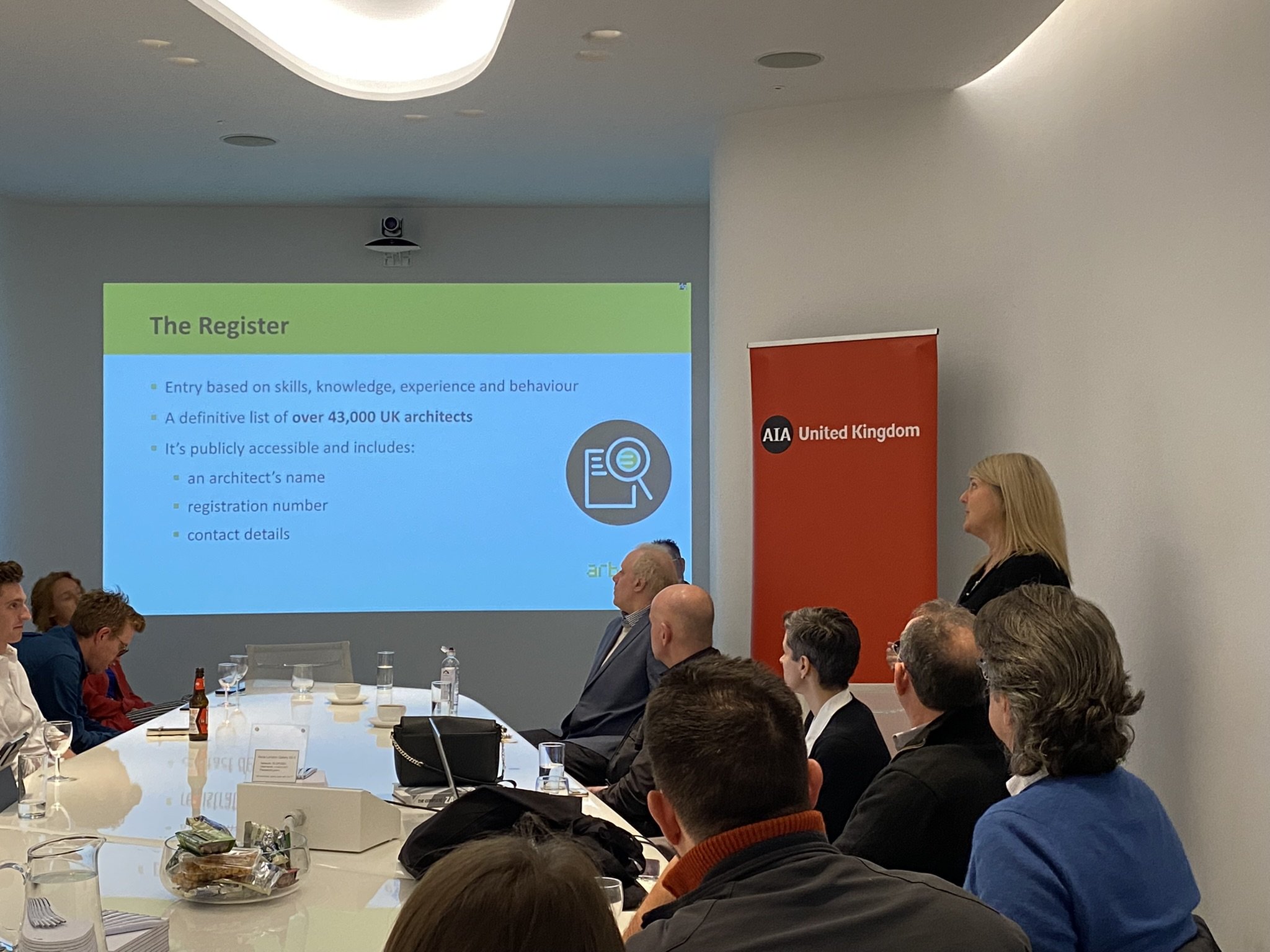LICENSURE MATTERS 2 / NCARB & ARB Describe Paths To Architecture Qualification
Fiona Mckay
At the 28 Sep 2022 Roca Gallery event described in Part 1, the speakers representing NCARB were Patricia Ramallo and Harry Falconer with Emma Matthews representing ARB. It was the first time the NCARB and ARB representatives had met their counterparts in person.
The speakers and event organizer. Pictured from left to right: Patricia Ramallo (NCARB), Harry Falconer (NCARB), Adelina Koleva (AIA UK Emerging Professionals), Emma Matthews (ARB). Photo courtesy of Roca London Gallery.
As Vice President of NCARB Experience + Education, Harry Falconer discussed the licensure processes for United States jurisdictions for architects on the Standard Architect Path. Typically, this refers to those who do have a NAAB-accredited US architectural education. Though the educational component is less available to UK-based candidates, Harry leads the development of NCARB’s education-related programs and is the point of contact for the NCARB Education Standard, Scholars in Professional Practice, Education Alternative for Certification, Foreign Architect Certification programs, and continuing education initiatives (CES, equivalent in the UK as CPD).
Harry is also in charge of professional support for the Architectural Experience Program (AXP). Unlike education, the experience component is readily available to US candidates based in the UK. US candidates can earn AXP hours while in the UK from both the “A” and “O” settings. The “A” setting requires a licensed US architect supervisor, while the “O” setting can be any licensed supervisor, such as a UK architect.
Harry Falconer, Vice President of Experience + Education at NCARB, presents to a captive audience at the Roca London Gallery meeting room. Photo by Adelina Koleva, AIA.
Following Harry, Patricia Ramallo spoke about US licensure for architects on the Foreign Architect Path. This typically refers to those who do not have a NAAB-accredited US architectural education, and received a degree or diploma accredited in another country. Patricia is highly knowledgeable in this area, having herself followed this path with an architecture background in Argentina. As Assistant Vice President of Innovation at NCARB, she is currently working to implement innovative strategies and advance international relations efforts.
Where the educational component is not automatically recognised in the US and an MRA is not in place, candidates have two options: to seek recognition of either (A) a foreign license or (B) a foreign education through EESA. Typically, both options will result in a more targeted appeal to a specific jurisdiction – in Patricia’s example, the US State Licensing Board of New Jersey. This is because the level of acceptance for the Foreign Architect Path sees more variation than the Standard Architect Path. Once of NCARB’s primary goals to improve standardisation and acceptance of both – but with independence bodies of governance on the level of both states and countries, this can obviously be very challenging.
Patricia Ramallo, Assistant Vice President of Innovation at NCARB, discusses the foreign architect path to certification in the US. She and her colleague, Harry Falconer (next to the presentation screen) travelled to the UK for the London Conference. Photo by Adelina Koleva, AIA.
Following Patricia, Emma Matthews spoke briefly about the processes for UK registration (licensure), both in terms of a “Standard Architect Path” and a “Foreign Architect Path.” In ARB terms, these are known respectively as the Standard Route to Registration and Alternative Routes to Registration. The Standard Route comprises of Parts I, II, and III which satisfy the education and experience components within the UK. Unlike the US, there is no ARE equivalent sit-down test that is required for UK candidates.
The Alternative Routes to Registration for candidates no longer includes any of the EU routes, which were formally revoked following Brexit. Candidates who do not benefit from Mutual Recognition – typically, non-US and non-Irish MOU candidates – will need to pass ARB's Examination for Equivalence to Prescribed Qualifications (also known as the Prescribed Examination) to progress towards registering as an architect in the UK. This requires the candidate to go through the Part I and II Exam interview process, prior to completing the Part III course and 2 years of work experience. Unlike the US, the UK does not currently offer an application process to directly recognise a foreign license – all Alternative Routes are focused on achieving core education equivalency, after which the candidate must still complete some experience and education in order to join the ARB Register.
This approach is unfortunate for the non-US audience and those who do not benefit from an MRA. On the bright side, the ARB only regulates title, and not the practice of architecture. From a day-to-day standpoint, this can be seen as a less restrictive measure than in the US, where the formal practice of architecture must be undertaken by a licensed architect. Nonetheless, the post-Brexit status of foreign licensed individuals – many of whom have high levels of expertise – does have a tangible detrimental effect on social and business standing. The ARB is currently working to address this through MRA agreements.
Emma Matthews, Director of Governance and International at ARB, presenting on UK paths to qualification. Photo by Adelina Koleva, AIA.
For the AIA UK and US audience, the new MRA agreement is on the horizon that will dramatically change opportunities. Once ratified by the UK government, this will be added to the Alternative Routes to Registration. According to Emma, the news so far is that the NCARB Certificate will be key to joining the ARB Register, in addition to one new Examination that will certify the candidate to the ARB panel. For the RIBA and UK audience, the ARB qualification will unlock the NCARB Certificate, which will allow registration in any US jurisdiction (state) that recognises the MRA agreement. As this is still under development, this remains to be confirmed as we await news regarding the specific procedures.
This article is a continuation of the 2022 LICENSURE MATTERS series. This is an ongoing story; please refer to NCARB and ARB for the latest information.
Written by Adelina Koleva, AIA
























